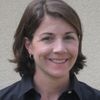
My grandmother died from a brain tumor on my 20th birthday. I was a junior at Davidson College. Before that, I had little experience with cancer. Two years later, I had moved to Los Angeles and was working at Caltech, in my first real job. A woman named Gail heard me say I had cut my friends' hair, and she asked me if I could cut hers. Next thing I know, I am in the dimly lit women's restroom, using orange-handled desk scissors to cut her curly, graying hair. Gail had advanced breast cancer. She had just started a new course of chemo, and clumps of her hair were falling out onto her desk while she worked. As a 22 year old with little previous cancer experience, this was a surreal experience for me.
Twenty years later, I am still living in LA, but cancer is not so surreal anymore. I am now one of 12 million cancer survivors in America. In 2005, I found a mysterious lump in my neck. I sought help at USC Norris Comprehensive Cancer Center. I was diagnosed with Hodgkin's Lymphoma, Stage 2B, at the age of 35. Hodgkin's is typically regarded as a young people's cancer, for people age 15-35, and then its prevalence returns again for 50-70 year olds. As younger person, I never dreamed I would get cancer. Growing up in the 1970s and 80s, the personal threat of cancer was not a reality. We believed that cancer was only for smokers and old people. However, today, five million of us survivors are younger than age 65, and current college students know far more about cancer than I did when my grandmother died.
The American Cancer Society operates its signature event, Relay For Life, in more than 5,000 local communities and college campuses across the country. In 2011, 400 Relays will take place in California, with more than 80 in Los Angeles County and another 30 in Orange County. The Relay, in which a team of participants run or walk for 24 hours straight, is more than a fund-raiser. It is about consciousness-raising, celebrating survivorship, memorializing lost loved ones and fighting back. Deeply committed and energetic students at Pepperdine University put on a Relay in April. More than 700 people joined 65 teams.
Curious about the impact cancer is having on today's college students, I, along with Pepperdine psychology professors Steve Rouse and Jennifer Harriger, surveyed students before they participated in the Relay. Out of the 173 participants who responded to our online survey, most were freshman, sophomores, and juniors. Forty-three percent had been in a Relay at Pepperdine in previous years, and 29 percent had participated in other cancer fundraisers. More than half indicated they themselves had donated money to a cancer-fighting cause prior to Relay. Only 2 percent had been diagnosed with cancer themselves, but one quarter had parents and siblings diagnosed and treated for cancer.
Furthermore, 88 percent of the Pepperdine Relay participants had extended family members -- such as grandparents, aunts, or uncles -- who had been treated for cancer, and 69 percent had lost extended family members. Nearly 40 percent indicated they had friends who had been diagnosed with cancer. Since personalities in popular culture influence public opinion, we asked them if they knew of celebrities who fought the disease. Forty percent answered yes and cited famous cancer patients such as such as Lance Armstrong, Michael Douglas, Christina Applegate, Farrah Fawcett, and Patrick Swayze.
Overall, 70 percent of students indicated they are at least slightly informed about cancer. Unlike me when I was young, they know that cancer is not just a problem for old people, and nearly half agree that cancer is on the rise for younger generations. There is hope! Eighty percent think there will be a cure for cancer, and more than half believe there will be a cure in their lifetime. The Pepperdine Relay raised over $50,000 to help find that cure. Many college students have been moved by cancer: 51 percent of Pepperdine Relay respondents indicated they might consider a career working for a cancer advocacy group.
In an effort to find the cure, a coalition of advocates including the American Cancer Society have put the California Cancer Research Act on the 2012 statewide ballot. The CCRA is expected to generate more than $500 million per year for cancer research by increasing the state's tobacco tax by one dollar per pack. Health care expenditures due to tobacco use costs more than $9 billion per year in California. Smoking costs Medi-Cal, our state's health insurance for low income residents, $2.9 billion per year. In addition to the funds generated for research to cure cancer, the CCRA expects to generate around $150 million per year to help control tobacco use, especially among our younger residents who are just coming of age.
